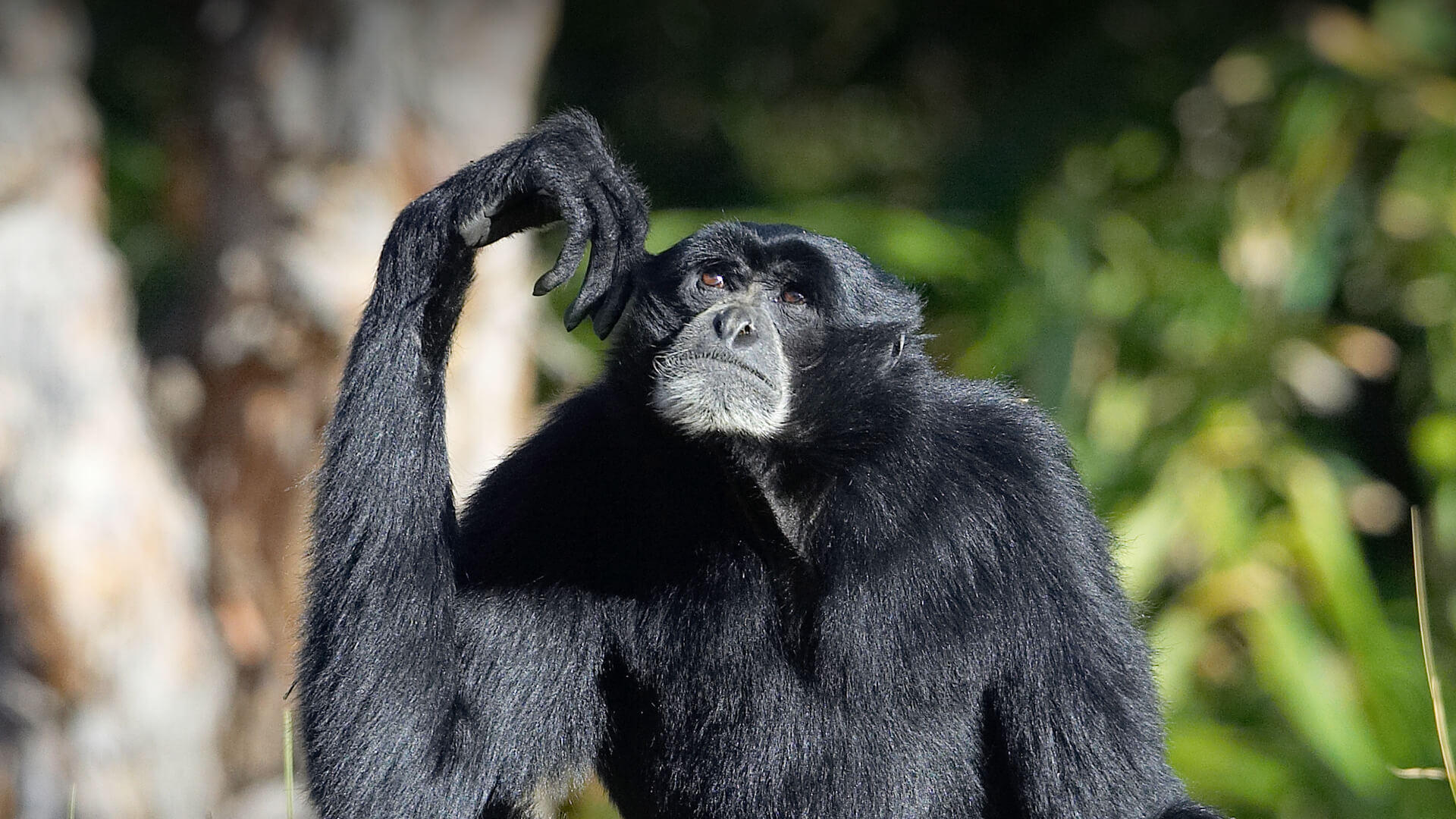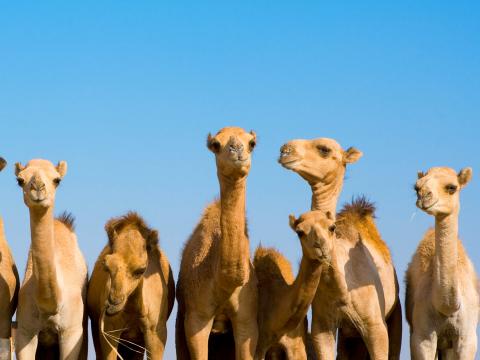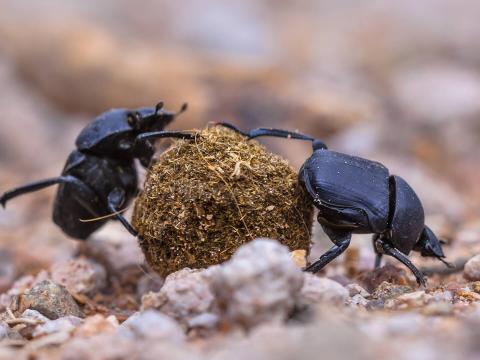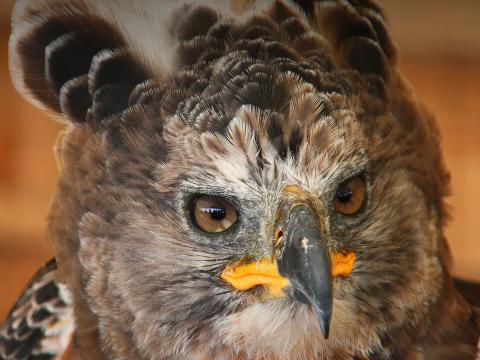Siamang
- CLASS: Mammalia (Mammals)
- ORDER: Primates
- FAMILY: Hylobatidae
- GENUS: Symphalangus
- SPECIES: syndactylus
ABOUT
Kings (and queens) of swing: Siamangs have slender bodies and lightweight bones for some serious swinging. The largest and darkest of the lesser (meaning smaller) apes, also known as gibbons, siamangs are well suited for life in a forest’s treetops. Yet there are some features of their hands and feet that make siamangs different from their gibbon brethren.
Siamang hands and feet are a lot like ours. They have four long fingers and a smaller opposable thumb on their hands, and their feet have five toes like we have, but their big toe is opposable, too. The opposable thumb and toe is lacking in other members of the gibbon family. Siamangs can grasp and carry things with BOTH their hands and their feet. One other thing that sets the siamang apart physically from other gibbons is webbing between their second and third toes.
HABITAT AND DIET
Life among the leaves: Want to find a siamang in its tropical forest home? Look up! They’re usually found in the trees at a height of 80 to 100 feet (25 to 30 meters) in Malaysia and Indonesia. How can you recognize them? Their furry bodies are black (both males and females), they don’t have tails, and they have a large gray or pink throat sac that inflates when they call. Unlike great apes, siamangs do not build nests, because they sleep sitting upright in the fork of a tree, usually alone but sometimes huddled together.
With arms that are longer than their legs, siamangs’ main way of traveling through the rainforest is by brachiation. The motion of their arms looks like the left-right motion of striding legs. During brachiation, siamangs hang from a branch by one hand while swinging their body around to allow the other hand to grasp the next handhold, just like you might do on a playground’s monkey bars.
Siamangs are very acrobatic and agile. Their extra-long arms help them cover up to 10 feet (3 meters) in a single swing. If they’re not swinging through the trees, they’re very likely walking along branches with their arms outstretched to help them keep their balance.
More than half of the siamang’s diet in their native habitat consists of fruit. They also eat leaves and the occasional protein snack, which might include small birds or their eggs, spiders, and insects.
The San Diego Zoo’s siamangs are fed biscuits made especially for zoo leaf eaters and a variety of fruits and vegetables such as oranges, apples, bananas, melons, grapes, yams, Romaine lettuce, spinach, turnips, carrots, and onions. They also get a selection of leafy material, including banana, hibiscus, and eugenia leaves.
FAMILY LIFE
In their native habitat, siamangs might travel up to a mile (1.6 kilometers) in a day. And when they’re not swinging through the trees, travel is on dry land (siamangs cannot swim and avoid the water). On the rare occasions they do choose ground travel, they walk on two legs, holding their arms over their heads for balance.
It’s early to bed for these tree dwellers! At around dusk, the family settles in to a regularly used sleeping tree for the night. The closeness of the family is unusual among gibbons. Siamang families like to stick together as they go about their daily business. During activities, members are only about 30 feet (10 meters) apart, on average, and rarely are they separated by more than 100 feet (30 meters). These social bonds are reinforced by lots of mutual grooming.
Siamang pairs usually stay together for life, one of the few primates to do so. When it comes to family life, siamangs stick together. A family group consists of one adult male and one adult female, along with two or three immature offspring that are only two or three years apart. A single baby is born hairless except for a small tuft on top of the head. The infant can hold onto the mother’s fur and cling to her belly soon after birth.
The father does his share of raising the baby and takes over the daily care of the youngster when it is about one year old. This is unusual for most other primates. The youngster is weaned early in the second year. Young siamangs stay with their family for five to seven years. Then they venture out on their own to start their own family group. The newly independent siamang, male or female, begins to call and move separately from its parents and may spend several years looking for a mate.
Siamang calls are legendary. All gibbons can make amazingly loud sounds, and the siamang’s "song" includes booms and barks, made louder by an inflatable throat sac. These booming calls can be heard up to 2 miles (3.2 kilometers) away through the forest. The calls are used primarily for claiming territory, which can be as large as 50 acres (20 hectares).
First thing in the morning, a family’s adult female usually starts a territorial hooting that the others join, and the noisy warning to other siamang families can last 30 minutes. Paired males and females also sing duets to one another, and each pair creates a unique song all their own!
CONSERVATION
Siamangs, like all gibbons, are Endangered. The main reason for this status is loss of habitat due to logging and agriculture. Additionally, many adults are killed, so their young can be sold into the illegal pet trade, even though siamangs are protected by law. San Diego Zoo Wildlife Alliance supports the conservation initiative of Association of Zoos and Aquariums’ Ape Taxon Advisory Group.
One of the best ways to protect habitat for siamangs is by recycling here at home. Products like glass and aluminum are made from elements in the rainforest soil, and by recycling cans and bottles, we don’t need to dig as much in these threatened areas. Reducing paper use will also help, since many of the paper products we buy in the US come from trees cut down in Indonesia.
By supporting San Diego Zoo Wildlife Alliance, you are our ally in saving and protecting wildlife worldwide.










